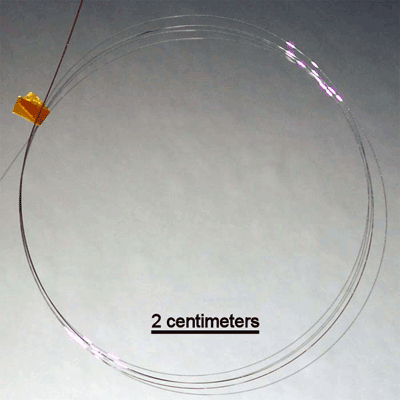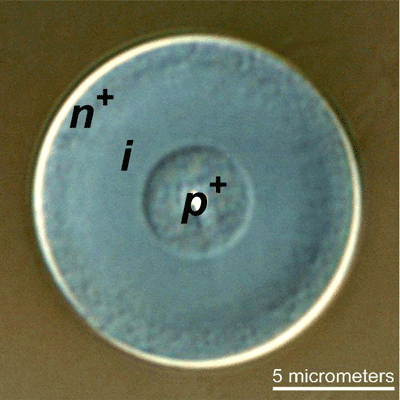Group creates optical fiber with solar-cell capabilities: Solar-power clothes next?
New technology can be woven together, could lead to solar fabrics
In what looks like a major breakthrough for solar technology, researchers have created a fully-flexible, silicon-based, optical fiber with solar-cell capabilities that can be scaled to several feet in length.

Coiled strand of a three-feet-long solar-cell junction fiber, thinner than the width of a human hair.
The findings come from an international group of chemists, physicists, and engineers, led by John Badding, a professor of chemistry at Penn State University. Their work was published in the journal Advanced Materials.
Building upon a previous breakthrough
The new fiber was built using a process the group developed earlier that addressed the issue of merging optical fibers with electronic chips. What they decided to do was, rather than try to merge a flat chip with a round optical fiber, they built an optical fiber with its own integrated electronic component. Using high-pressure chemistry techniques, the team deposited semiconducting materials directly into tiny holes in optical fibers, layer by excruciatingly tiny layer. Doing this, they discovered, allowed them to completely bypass the need to integrate fiber-optics with chips.
With this new technique in place, the team then moved on to build a fiber out of crystalline silicon semiconductor materials that function as a solar cell.

Cross-sectional image of the new silicon-based optical fiber with solar-cell capabilities. Shown are the layers – labeled n+, i, and p+ – that have been deposited inside the pore of the fiber.
“Our goal is to extend high-performance electronic and solar-cell function to longer lengths and to more flexible forms. We already have made meters-long fibers but, in principle, our team’s new method could be used to create bendable silicon solar-cell fibers of over 10 meters in length,” Badding said.& #8220;Long, fiber-based solar cells give us the potential to do something we couldn’t really do before: We can take the silicon fibers and weave them together into a fabric with a wide range of applications such as power generation, battery charging, chemical sensing, and biomedical devices.”
Longer battery life
As Badding explained, one of the major limitations of portable electronics like smartphones and tablets is short battery life. A solar-boosted battery based off technology that uses the technique described above could prove quite valuable to these markets.
“A solar cell is usually made from a glass or plastic substrate onto which hydrogenated amorphous silicon has been grown,” he said in the University’s press release. “Such a solar cell is created using an expensive piece of equipment called a PECVD reactor and the end result is something flat with little flexibility. But woven, fiber-based solar cells would be lightweight, flexible configurations that are portable, foldable, and even wearable.”
At this point, the material could be connected to electronics devices to both power them and charge the batteries. Badding adds, “The military especially is interested in designing wearable power sources for soldiers in the field.”
Additional advantages
The team points out that another advantage of this technology is that its flexibility allows the solar-cell materials to collect light energy at different angles.
“A typical solar cell has only one flat surface,” Badding explains. “But a flexible, curved solar-cell fabric would not be as dependent upon where the light is coming from or where the sun is in the horizon and the time of day.”
They’re also fairly small, and quite fast. Team leader Pier J. A. Sazio of the University of Southampton in the United Kingdom, adds, “Another intriguing property of these silicon-fiber devices is that as they are so compact, they can have a very fast response to visible laser light. In fact, we fabricated fiber-based photodetectors with a bandwidth of over 1.8 GHz.”
Register to download “ Silicon p-i-n Junction Fibers ”.
Story via: psu.edu
■
Advertisement
Learn more about Electronic Products Magazine






